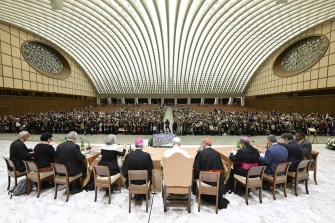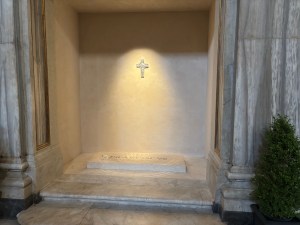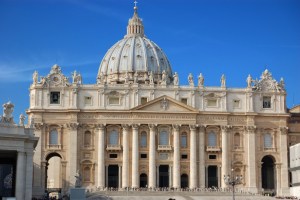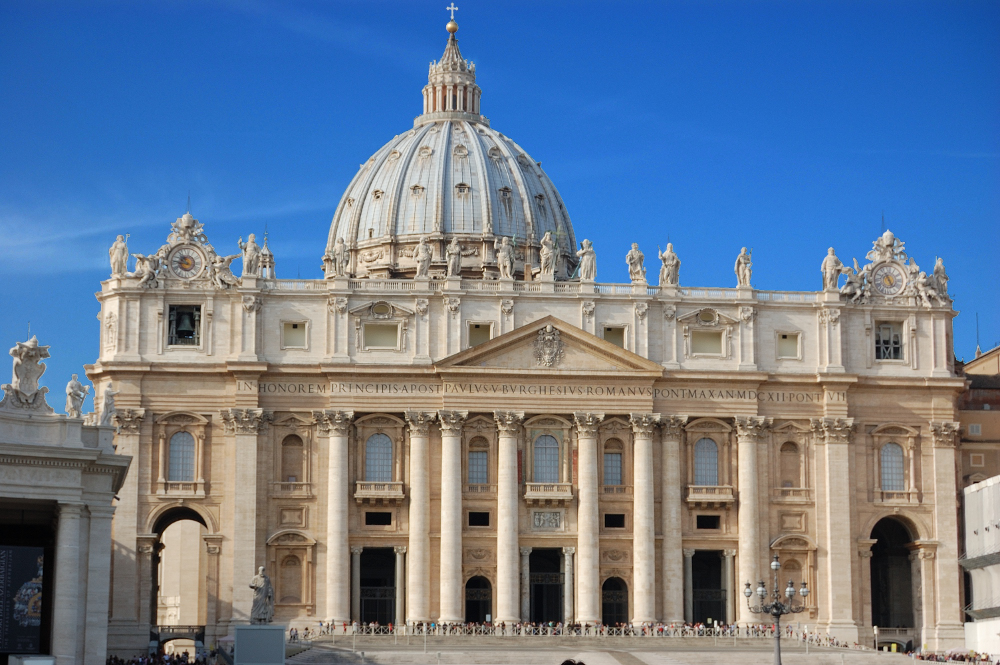

Robert Shine
Today’s post is from guest contributor Robert Shine (he/him). Bob is the executive director of the Pax Christi International Fund for Peace, a part of the global Catholic peace movement. He previously served at New Ways Ministry from 2012-2024, including as Bondings Managing Editor, and is a co-author of “A Home for All: A Catholic Call for LGBTQ Non-Discrimination.”
Even for small churches, the outpost in Ireland’s west coast where I found myself on a trip in September was tiny. A few short pews. Simple altar. Forgettable Stations on the walls. And yet this space was expansive and rich for me because it is where my great-grandparents lived their faith before emigrating to the United States. I pictured this community decades ago, perhaps a Mass with preconciliar vestments and veiled women, celebrated in Latin. Infants drizzled with the water and oil of baptism. Children receiving Eucharist for the first time. All too frequent moments of grief and loss.


The little church in Ireland
That region of Ireland is a place of revolutionaries, of a people who defied colonization by stoking faith’s fires. Occupied, when British soldiers would come to harass that church and others, my ancestors would flee into the mountains to celebrate Mass. They were pious, I imagine, in the way many Irish Catholics were then. Marian statues. Worn-down Rosaries. Perhaps a cheap print, though framed and prominently hung, of the latest pope.
It was this chance stop, not on our itinerary, that exposed to me a deep root of my spiritual journey I had not known was there. Despite an ocean and a century between us, when I stood in that church, the sense of communion with my ancestors in faith was strong. And these ancestors included my great-grandmother, who refused to kneel when priests passed by, as was Irish custom, saying that a priest “was just another mother’s son.”
——————–
Two weekends ago, in the audience hall abutting St. Peter’s Basilica, Pope Leo XIV entered to great applause and with little personal flair, greeting those on stage and beginning the dialogue with Synod teams and organizers. I was invited to join this pilgrimage weekend, part of the Jubilee Year of Hope, a year after I was last at the Vatican for New Ways Ministry’s work at the Synod on Synodality.
For four years, the synodal process was like a heartbeat in both my professional work and spiritual life. Pope Francis was, at last, bringing the church back to where Vatican II had left off. At New Ways, I helped convene the largest-to-date survey of LGBTQ+ Catholics and allies about their hopes and joys, griefs and anxieties. We compiled these learnings into a report sent to (and warmly received by) the Vatican, and continued helping our community engage the Synod at each phase. Frank DeBernardo and I dutifully and daily covered the Synod assemblies from Rome, and the innumerable developments in between, here at Bondings.


Pope Leo and church leaders preside over session in Paul VI Audience Hall during the Jubilee of Synodal Teams.
Twice during those assemblies,Pope Francis received New Ways Ministry in a private audience. The second time, transgender and intersex Catholics and their loved ones told Francis their stories for nearly an hour and a half, to which he responded warmly. If I ever doubt God’s existence or love, I need only re-enter that room to know how real they are.
I confess, though, that the synodal process was more often a disappointing slog for LGBTQ+ Catholics and our loved ones. We showed up each time we were asked, forced to put aside the ways the church has and continues to harm us. The grace we offered, to see beyond present divisions in the hopes of finding a common future, was not always returned. But a gift LGBTQ+ Catholics offer the church is persistence, and through the synodal process, the queer faithful decidedly offered it again and again.
Since leaving LGBTQ+ ministry at the end of last year, my life is far less attuned to church events, at least professionally. I do not follow the day-in, day-out happenings of the Vatican or bishops conferences (though I do subscribe to Bondings!). So, listening to Pope Leo on stage at the pilgrimage felt like a novel opportunity to gauge who he was, what his vision of the church is, and whether it will make any difference for queer Catholics like me. I also hoped to understand more about where the synodal process had ended up, and if the continued “walking together” was headed anywhere worthwhile.
——————–
I entered the Basilica of Santa Maria Maggiore alongside a woman who looked up at the gilded ceilings and admired, “Trump would love this.” That we were queuing to visit the tomb of a man who demanded we love migrants and all who are marginalized seemed lost to her. To view Pope Francis’ tomb, one must wait in line for quite a while. But for once, I found lining up to be a grace, for it gave me time to make sense of my scattered thoughts and emotions.


Tomb of Pope Francis in the Basilica of Santa Maria Maggiore
The tomb is simple, barren even. A lit-for-purpose alcove. Below, an engraved marble slab. Above, the pope’s pectoral cross of the Good Shepherd. Simplicity is good, for a guard rushes you along, so you get only but a glimpse. Fortunately, there were chairs nearby that provided me space to pray, and to cry.
Like so many of us, I grieved deeply when Francis passed. We had lost not a pope, but a pastor, a friend, a sibling. We had lost the voice of “todos, todos, todos!” and who knew at that time of conclave if such a voice would be again silenced. Pope Francis sincerely loved LGBTQ+ people and desired for us to be in the church. And, like any love, his was always imperfect for us. But it was real love, and that was real change.
——————–
In Rome now, I feel the loss of Francis’ anew. His successor, Leo, is a strong advocate for many—the popular movements who also had their Jubilee pilgrimage at the end of October, Palestinians facing genocide, migrants being abducted in the U.S., the materially poor in every place, and the cause of global peace and nonviolence. But judging from this audience, along with his comments in his first interview early in October, and the smattering of news I read, I worry that Leo lacks the boldness of Francis so essential to cutting through our church’s neuroses on sexuality and gender.


St. Peter’s Basilica, Vatican City
A year later, I remain convinced that these neuroses, like the inability to affirm queer love, celebrate trans joy, ordain women and nonbinary folks, and respect the consciences of faithful Catholics, are the crux of what happened during the synodal process—and what hindered it. Listening to Synod officials during this pilgrimage was distressing, and I am not sure the right lessons are being learned. This pilgrimage during the Jubilee Year of Hope could have me leaving Rome with less hope than when I arrived.
But where the Vatican lets me down, the people of God lift me high.
This week, I recall vividly the communion of saints in whose path I follow. My ancestors in Ireland, who celebrated Mass in the hills, at the margins, when needed. Pope Francis, who refused to let his love for us be obstructed by curial sabotage. The many more examples of heroic lives we each carry. And I journey in my own life alongside a rich community of justice-minded Catholics, including my LGBTQ+ siblings, who likewise refuse to let our faith be suppressed or our love be obstructed.
I would prefer to be wrong. How great if our years of synodal listening becomes substantive action, led by a new pope unafraid to really love us, all of us. But the fate of our faith does not hinge on this.
The words of my great-grandmother and Pope Francis both remain true. Unhelpful clerics have no monopoly on our future, for they are not princes but simply other mothers’ sons. It is us—todos, tutti, everyone—who determine that renewed ecclesial future. Whether that comes from the Synod, who knows? But by my faith in God’s people, both those past and those present, I leave Rome with this certainty: I am a pilgrim of hope.
–Robert Shine (he/him), November 5, 2025
Related
